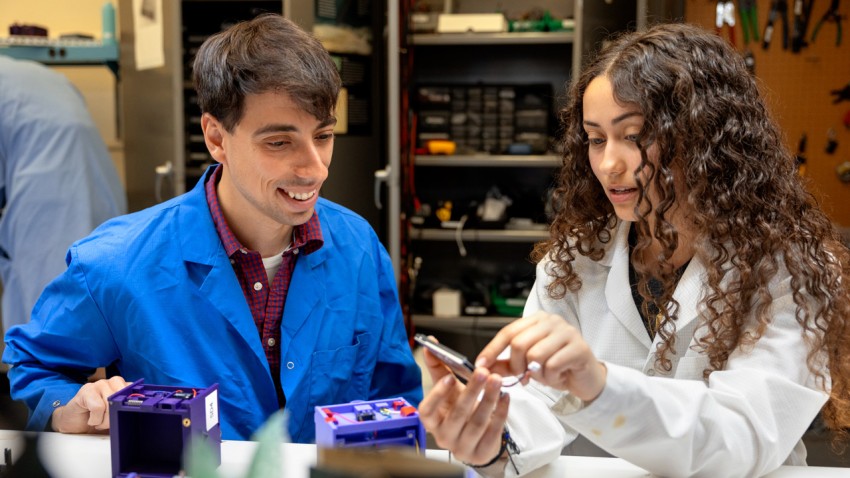What does it take to get a small, student-built satellite to the International Space Station (ISS) for testing in orbit? The answer is eight years of effort, contributions from over 120 undergraduates, industry collaboration, and a significant amount of glue. This fall, the Alpha CubeSat, a project born from Cornell University’s Space Systems Design Studio (SSDS), is scheduled to be launched to the ISS. In addition, a related project, “Sailing to the Stars,” will also make its journey to the space station in late summer. This project aims to test six light sails that could one day propel small spacecraft through interstellar realms.
Both projects are spearheaded by students and have been nurtured under the guidance of Mason Peck, the Stephen J. Fujikawa ‘77 Professor of Astronautical Engineering at Cornell. “These space-technology experiments take fundamental research into orbit, elevating new ideas beyond mere paper studies and proving they work,” Peck explained. “It’s rare enough for a student to be able to launch their senior project, but Cornell may be unique among U.S. universities in how we introduce students to game-changing technology research as experiential learning.”
The Journey of Alpha CubeSat
The Alpha CubeSat project was initially proposed in 2016 by Isabel Dawson, then a sophomore at Ithaca High School. Inspired by a lecture from Peck, Dawson led her team to win an international CubeSat design competition. This victory laid the foundation for collaboration with Cornell students to transform the design into a functional satellite. Over the years, the project saw contributions from multiple generations of engineering students.
Doctoral student Joshua Umansky-Castro, who joined the project in 2019, recalls the challenges faced during the pandemic when the original team had dispersed. “I learned everything from the ground up,” he said. “When the campus reopened, we started redesigning everything, getting the electronics to work, getting a whole new ChipSat designed. Even the sail had to be modified.”
Technical Challenges and Triumphs
Lauren Greenhill, a senior at Cornell, was responsible for rewriting the programming and leading a team to ensure the source code was flight-ready. “Alpha has been the most important part of my Cornell experience,” she reflected.
The project also benefited from the mentorship of Silicon Valley engineers and industry partners like Avery-Dennison Corporation and Voyager Space, which helped facilitate NASA safety approvals. In March, after a grueling push to finalize the hardware, Alpha was packed and delivered for launch.
“It was definitely crazy,” Umansky-Castro said. “There was a point I started calculating how many hours I had left and realized, wait a second, I can’t leave the lab.”
Sailing to the Stars: A Swift Development
Compared to Alpha CubeSat, the development of “Sailing to the Stars” has been relatively swift. Verena Padres, a mechanical and aerospace engineering student, became the project lead in the fall of 2023. Her leadership has been pivotal in bringing the project to its current state of readiness.
Padres and her team have worked tirelessly, often spending late nights in the lab to make last-minute tweaks before shipping the light sails to their industry partner in Houston. The project involves testing six sails and two different deployers, with astronauts setting up video cameras to capture the hour-long experiment.
“What does the sail look like coming out? Is it tumbling? Is it wobbly? Is it not open all the way?” Padres pondered, emphasizing the importance of understanding the deployment process.
Looking Ahead: The Impact and Future Prospects
As the launch dates approach, the students are filled with anticipation and anxiety. The success of these projects could pave the way for future endeavors within the SSDS pipeline, such as DeSCENT, which aims to release 100 ChipSats to study their dispersion in the atmosphere.
Parishee Bajaj, a member of the team, highlights the significance of these projects for students. “Even after Alpha has been reduced to cinders, the data we collect will inform future projects,” she noted.
For Umansky-Castro, the journey does not end with this launch. He plans to continue his involvement in ChipSat design, either as a postdoc or an independent consultant. “It’s been a dream of mine to send something into space,” he said. “And I’m so thankful to have this opportunity at Cornell to do it and to share that experience with all these students who also want to do the same thing.”
The upcoming launches of Alpha CubeSat and “Sailing to the Stars” not only represent significant achievements for the students involved but also showcase the potential of student-led projects in advancing space technology. As these satellites prepare to embark on their journey, they carry with them the hopes and dreams of the next generation of aerospace engineers.
